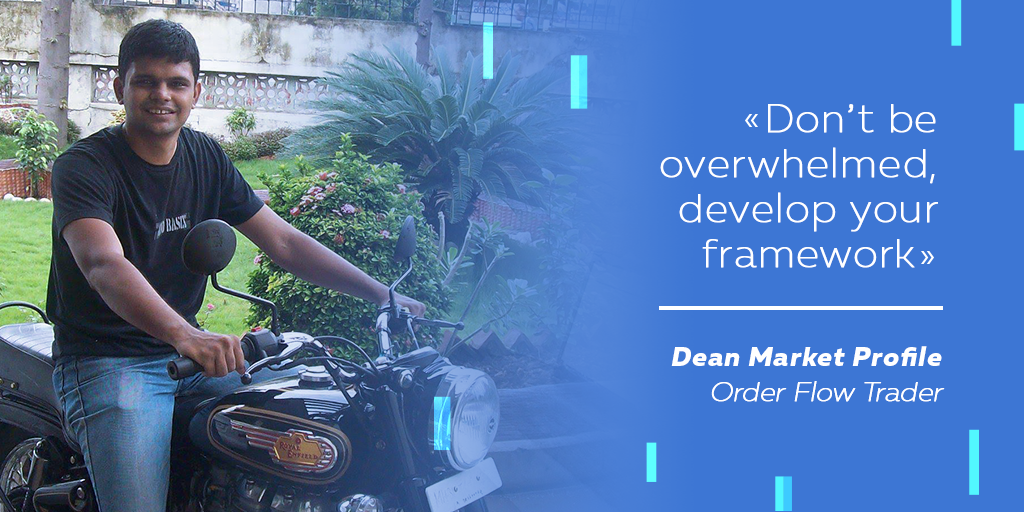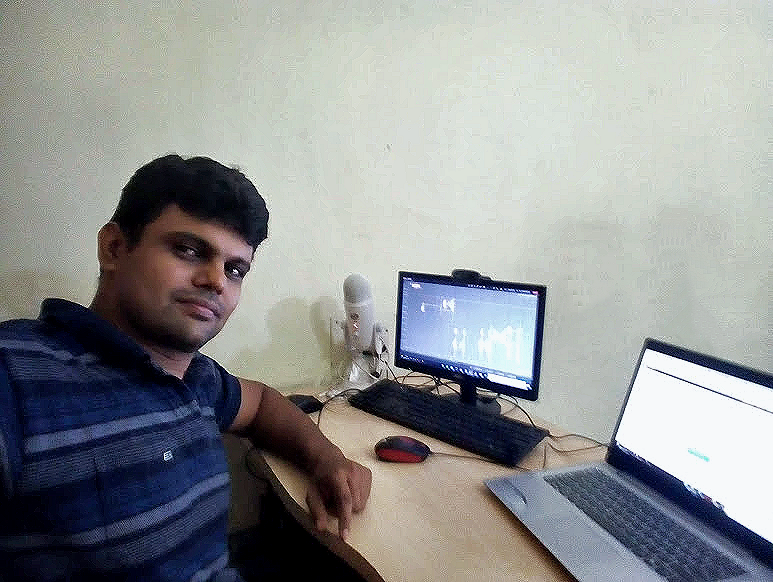Ready to see the market clearly?
Sign up now and make smarter trades today
Interviews
August 10, 2024
SHARE
Trading Depth Interview #8: Riding the Order Flow in Indian Markets

Welcome Dean Market Profile in our traditional rubric the Trading Depth with professional traders. Dean is from Nagpur, India, and has marked 13 years of trading experience after starting it in 2005.
He trades options and futures on the Nifty 50 (TOP 50 stocks) and Nifty Banks (TOP 30 banks) indices on the NSE — National Stock Exchange of India. These are more volatile than the S&P, so we talked about the strategies Dean applies in this market, why he is willing to share his knowledge, and how to neglect all the clutter and focus on the order flow and market profile.
Dean, why did you leave your job and became a trader?
I was working with a car manufacturing company, and I just was not happy with the nature of the job. So I was looking into alternatives. In India, it’s much easier to open a trading account and many people try it part-time. I really got fascinated by this idea and thought that I would pursue it all the way. Having an engineering background, I believed that there was nothing I could not do *laughs*.
How was it in the beginning? What was the first instrument you traded? Were you lucky enough to win the first trade or you lost some money?
Hehe, it was not at all what I expected it to be. Having the math and analytical abilities definitely paid back since it is so relevant in trading. But after being in the field for many years, I realized that real trades are about psychology. I did not have that deep understanding of psychology and I had to pay a price for that. I had the idea of how binary options and futures work but converting that knowledge into profitable trading takes a lot of time. Obviously, trading has changed a lot since then. It doesn’t look like what I was doing in the early days. I learned it by trial and error.
In this regard, do you use technical or fundamental analysis more? Do they even matter since you trade with order flow?
For the first half of my trading career, I focused on a technical analysis. I looked for trend lines, channels, patterns, and lots of indicators. Then, I moved to Elliot waves. Finally, I settled with trading the Market Profile, Order Flow, and Volume Spread Analysis (VSA). These are the three tools I use in my daily trading.
What is the ratio of your winning trades?
From 60% to 70% of my trades I either win or break even. I don’t rely on fixed patterns. Most of the time I am getting into successful trades but if I feel that the market is not working in my favor or as I expected, I would scratch that trade.
After trading for so long time, do you think you have developed your own style?
I have started to look at a bigger picture more. Entry setups, exit setups, all of those indicators — this is how zoomed-in I used to be. What I have done for the last few years, I started looking at the bigger picture, what the market is doing and then try to assess the risk of either going short, or long. I do that by market profile mostly. Using the order flow, I would time my trades — the ones that are less risky.

Can you tell us a bit about your students at Get That Trading Edge? When did you start, what was your motivation behind it? What was their feedback?
I used to share my trading analysis on social media platforms. I had some Facebook pages, a Twitter profile, some elementary blogs. What happened, people started inquiring about why I was doing what I was doing. Why I felt the market would go up or down. It was very difficult to explain to each person the reason and motivations behind my trades. Therefore, I converted all my learning into a course and offered it to people. I started it last July (2017), and last month I also launched the order flow course. I planned to bring out three or four courses, and two of them are ready. People are really happy about them.
That’s nice. So for a fixed amount of money they are able to join the course. Is that correct?
Yes. These are video courses. The Market Profile series contains 45 videos, the Order Flow course is a bit shorter. You can find them on my website. Most of my students are from abroad, around 50%. They learn about market profile, and by applying the order flow technique they can trade any instrument.
Trading is a stressful activity. How do you release stress? What do you do in your spare time?
I work out. For the last couple of years, I’ve been enjoying developing websites. I used to do those elementary blogs, as I already mentioned, but then I wanted to build a website so I searched on the Web how to do that. As a result, I have designed my website myself. So even my hobby became connected to my main activity. Mostly I try to understand how online business works.
It’s interesting: you are constantly learning, and everything you do seems to be related to trading. Do you think that over the years trading became easier, or it’s not the case?
Obviously, it did become more manageable. The turning point was to realize that instead of trying to look at all different information sources, usually, we need a framework that can put everything in proper context and place so that you can make a right decision. You know, there are zillions sources of information — you have real-time data for prices and volume — and a lot of this information is getting thrown at you. You need a framework that can crystallize it and give a clear picture about what the market is going to do at the present moment. And then you decide whether to trade or not.
So what are the most important factors for the software?
Since I use Market Profile and Order Flow, these are pretty software-intense. You need reliable software if you are going to use these tools. It must uncover critical information, right? What is going on in the market or what you see in the price or the order flow ladder. You know, it’s not clear what exactly is going on. Sometimes tools may even mislead amateur traders. You need to understand what information software can uncover for you. Then it becomes really helpful. Obviously, good software is a must if you want to use such advanced techniques in your trading.
Was it a challenge for you to evolve as a trader?
I started trading first, made a lot of mistakes, and then looked in retrospect: why didn’t I succeed, why didn’t I do it the way successful traders did it?
What is your long-term goal? Do you have a specific goal you want to reach before retirement and traveling the world? Or will you just continue trading, if reached the goal, just because it’s fun?
I like it actually. I really liked the moment when I found out about trading and what it can do. I read a few books and realized that I wanted to do it full-time. My dream of becoming a professional trader evolved on the first trades because I decided to trade from the very beginning. Only when I explored the reality of it, I had to learn more and do enough of retrospection. I don’t think I will do anything else except for trading. Maybe, I’ll travel later.

Dean with his family
That’s right. You will definitely find some time to travel. And sometimes it’s good to take a break, recharge physically and emotionally, and then return to trading and be even better at what you do. Back to India: since you trade Nifty indices, could you tell the specifics of the market? Perhaps, some of our readers would like to trade Indian stocks.
India is one of the top emerging countries. It’s growing very fast in comparison to more developed nations. There are a lot of opportunities here, you know. Companies start small but the potential opportunity for growth is tremendous. What happens is if you are an investor or a trader, and you have a risk capital to use in a long-term, India might be a great option.
The liquidity, of course, cannot be compared with the US equities. On the other hand, it’s still a sufficiently liquid market. And if anybody is willing to enter it, this is a really good time to enter it.
Are these markets quite volatile?
Yeah. Because what is happening now, the global economy is interconnected closely. The information flows pretty fast. So if Trump suddenly tweets something, that immediately has an impact on the world market.
What if one of our readers wants to pick one stock, would you recommend any?
No, I don’t trade individual stocks.
Alright. Let’s talk more about order flow. Is there anything particular you would like to share? It’s interesting to see how different traders interpret it.
Yes. The framework I was talking about, I call it the LCT framework. L is for Logic. You need something that gives you a rationale for the market moves. Then C stands for Context then I try to convert that rationale into market opportunities using the Market Profile. After that comes the timing, T stands for Timing, I use Order Flow specifically for timing purposes.
In that, I try to see what side the smart money is on. You must be aware of the important visual references, like yesterday’s high, or yesterday’s low. So once the price or the auction reaches those levels, I see if it is a right place to enter a trade. And if it is, then I will move on to the order flow chart and look for different patterns which tell me about the right time to buy. I look at passive buying — the limit orders. These are predetermined references for absorption.
While using this technique, any technique, there is always a chance for an error. How do you manage these situations, including panics in the market? Let’s say, Trump tweeted something triggering?
You cannot control such things. What I do is trying to manage risks by using option spreads. So even if the market does not go in my favor or there is a big gap, you have an ample amount of space to manage your position.
We also ask traders very uncomfortable questions. Of course, these appear to be their favorite. How much did you lose the most? How did you feel, how did you react to this?
My trading losses never were big ones. I used to get in that phase when I make 5 to 10 great trades and then make a lot of money but then I suddenly changed my behavior to get into a losing street. Even if I had many profitable trades but then three bad trades, the whole psychology changed and I would lose more to win back instead of looking at what I did wrong in the first place. That was the biggest problem.
Do you think it is connected with consistency?
Yeah, that’s what happened but I kept working on it.
Did you visit any trading room or chat?
I have been interacting with many traders on social media. But I never joined any trading room.
What is the role of intuition in trading?
I think it will develop over time. Unless and until you have a solid framework to base all your analysis on, I don’t believe that intuition would stay with you. You might feel that whatever is coming to you is working in the market, but the market is constantly changing. So if the intuition doesn’t change (adapt), it may not work as it used to (expertise).
What happened to me: I studied a lot. But then I started using a framework and converting my knowledge into profitable trades. The more profitable trades I took, it reinforced my knowledge. Of course, it was really difficult to get out of that vicious circle while attempting to get the lost money back. But now even when I lose on a trade, I try to learn from it and incorporate my analysis and move forward.
Do you think a trader can be a team leader or better stay independent?
It all depends on the number of instruments you trade. Currently, I trade three instruments and I can cover those myself. In case you capital reaches beyond that amount, you might need more people to help you because it’s incredibly hard to keep track of them.
A couple more question from us, Dean. Can you recall your biggest win and how did it feel?
My biggest win was not actually a win. I was not the trader back then that I am today. And that was before the general elections of 2010, I guess, when the government got re-elected. The results came out on the weekend. I got into some long trades on Friday. When the market opened on Monday, it actually hit upper circuit. So that was the time when I made the most money on a single day, but it happened because of the government news. I was lucky but, in fact, I was risk-blind at that time. Ever since I avoid such events.
What books would you give as a gift to your friend-trader?
The book that made the biggest impact on me was actually a non-trading book. It’s Fooled by Randomness by Nassim Taleb. I refer to it in any situation: when I am happy, or when I am sad. Also, I would recommend his other two books The Black Swan and Antifragile. All of them are good in terms of understanding the risk in the markets.
Another one is the classic, Reminiscences of a Stock Operator by Edwin Lefèvre. I read it, probably, a hundred times. It is both a great story and has a lot of trading wisdom. Every time I read this book I learn something new.
Thank you, Dean, for talking with us.
Where to follow Dean:
Website: Get That Trading Edge
Twitter: https://twitter.com/aniruddha4tew
Key takeaways:
- Real trades are about psychology
- Instead of various information sources, better rely on a framework
- If the intuition doesn’t adapt, it may not transform into the expertise
- Avoid big news, trade in the present
This is part of the Trading Depth project, a series of inspiring interviews with successful traders. For more interviews with traders follow our Twitter and Facebook.